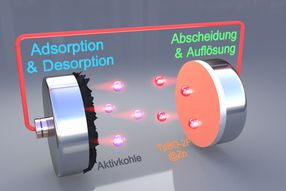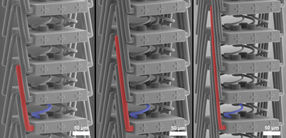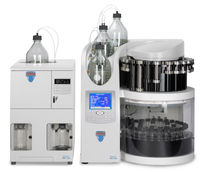New web database improves access to ionic liquid data
Chemical engineers and others designing "green" industrial processes using new ionic liquid solvents now have an important new resource, an on-line database of physical properties developed by the National Institute of Standards and Technology (NIST).
There has been an explosion of interest in the last few years in the synthesis and use of ionic liquids--salts that melt below the boiling point of water. A large part of the interest is due to something ionic liquids don't have: a measurable vapor pressure at room temperature. With typical vapor pressures in the range of 10-10 pascal (10-14 psi), ionic liquids have essentially no vapor emissions and so look like excellent candidates for "green solvents" to replace hazardous, air-polluting organic solvents like acetone and benzene. With dozens of anions and cations to choose from, they can be tailored to specific needs and may be particularly useful as solvents for biocatalysis.
One problem has been a lack of organized, reliable data on the basic physical properties of ionic liquids, critical information for designing industrial processes. NIST, in cooperation with the International Union of Pure & Applied Chemistry (IUPAC), has created ILThermo, the IUPAC Ionic Liquids Database. Launched at the end of July, ILThermo is a free, web-based research tool that allows users worldwide to access an up-to-date data collection of thermodynamic, thermochemical and transport properties of pure ionic liquids as well as binary and ternary mixtures.
Assembled from published data, ILThermo aims to include information on structure, thermodynamic and transport properties of pure ionic liquids and mixtures. The inaugural version of the database includes data for more than 200 ions and more than 300 ionic liquids. A particularly valuable feature, according to Michael Frenkel of NIST's Thermodynamic Research Center, is the inclusion of uniformly calculated uncertainties (following guidelines adopted by the major scientific unions and NIST) for each data point in the collection, making it easier to compare the quality of different measurements.
Other news from the department science
These products might interest you
Most read news
More news from our other portals
See the theme worlds for related content
Topic world Synthesis
Chemical synthesis is at the heart of modern chemistry and enables the targeted production of molecules with specific properties. By combining starting materials in defined reaction conditions, chemists can create a wide range of compounds, from simple molecules to complex active ingredients.

Topic world Synthesis
Chemical synthesis is at the heart of modern chemistry and enables the targeted production of molecules with specific properties. By combining starting materials in defined reaction conditions, chemists can create a wide range of compounds, from simple molecules to complex active ingredients.

































































